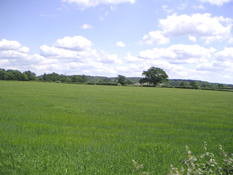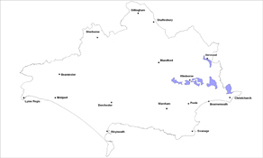River terrace


Location
The River Terrace landscape type is found along the fringes of the Stour, Moors and Avon river valleys.
Key Characteristics
- a wide and flat landform with deep alluvial and gravel soils
- a buffer between the heathland landscapes and the valley pastures
- mixed agricultural land of arable and livestock with some marginal ‘urban fringe’ farming
- fields subdivided by low hedges and or fencing
- scattered farmsteads across the rural parts
- some quiet relatively isolated areas
- rivers have little impact on overall character
- woodland blocks and shelter belts are key features
- heavily influenced and impacted on by urban development including sand/gravel extraction, power lines and transport corridors and the South East Dorset conurbation
The River Terrace alluvial and gravel landscape acts as a transition/physical buffer or barrier between the heathland and heath/farm/forest types and the river valley pastures. The medium scale landscape has a largely flat land form with a rural mixed farmland character. The field boundaries are often lined with low hedges or fencing and woodland blocks and shelter belts form important landscape features and backdrops. Many of the shelter belts have pines as part of their makeup. Adjacent to the Bournemouth/Christchurch/Poole conurbation the area is heavily influenced by housing and other development such as mineral extraction, power lines, transport routes and Bournemouth airport which all contribute to a neglected/ under managed feel in places. Away from this edge there are some quiet lanes and paths which act as important accessible recreational areas. There are a few scattered farmsteads, hamlets and important small village cores such as at Sturminster Marshall, Ashington, Hampreston and West Parley across the more rural parts of the terrace. There are important groups of interconnected trees, copses and tall mature hedgerows which frame horizons and vistas in places. Important remnant rural features are still evident and add to character such as roadside ditches, ‘soft’ highway edges and verges, old boundaries and the use of locally distinctive building materials. The terrace landscape has historically been the location for large homes and parkland. Canford School and its planned parkland in Poole is an example of this and forms a key landscape feature.
Management Objectives
The overall management objective for the River Terrace Landscape Type should be to maintain and enhance the value of the area as a buffer, control and minimise the impact of development and transport infrastructure/use and the opportunities for large scale multi functional landscape restoration and creation should be promoted and explored.
Key land management guidance notes
- promote the use of the area as a multi functional landscape resource in coordination with the Valley Pasture landscapes and in particular as an informal recreational resource
- maintain and enhance remnant rural roadside features such as ‘soft’ verges and ditches
- conserve, enhance and manage woodland, hedgerows and the distinctive mixed shelter belts
- strengthen the character of this area through existing and any future landscape management initiatives
- create, conserve and enhance open space areas as strategic open areas between important heathland and densely populated areas
- control the impacts of housing and other development such as roads and other transport uses e.g. with sensitive site planning decisions based on an understanding of local character
- strengthen the eroded character of this area for example by seeking to integrate new and existing development in a more sympathetic way e.g. by using new and existing woodland blocks and shelter belts to integrate development
